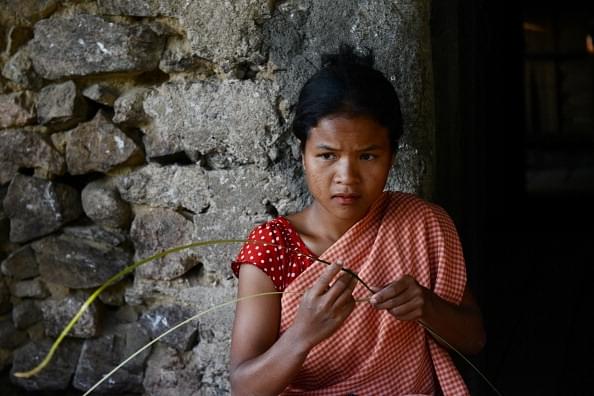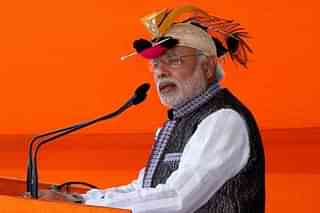Culture
One Size Does Not Fit All
Vanita Viswanath
Mar 09, 2016, 03:49 PM | Updated 03:49 PM IST
Save & read from anywhere!
Bookmark stories for easy access on any device or the Swarajya app.

As India moves towards the implementation of the United Nations’ Sustainable Development Goals (SDGs), it may be a good time to re-look at the women’s-rights-based approach it emphasises. The targets specified for gender equality go much beyond those of the Millennium Development Goals (MDGs). The UN Women World Survey report of 2014 that preceded the adoption of SDGs attempts to see all issues facing women as rights issues based on unequal power relations within an overarching framework of human rights.
This is an acultural position in advancing sustainable gender equality.
Gender inequality can be broadly attributed to institutionalized, generationally transmitted beliefs about the differential roles of men and women and these play out economically, politically and socially in non-mutually exclusive ways. Scholars in India and outside have recognized the importance of class, kinship, culture and a range of intermediation factors from micro to macro that defies a one-size-fits-all approach. While these analyses have been useful for articulating the complexity surrounding gender inequality, they have been less influential in policy and development prescriptions internationally.
Rights And The State
The UN has been guided by the feminist movement of the US and the UK that upholds discrimination as the key factor in gender inequality and, hence, pushes for women’s rights as the key solution. Its charter and prescriptions for its member states made the strongest articulation of the rights approach in the Beijing Platform for Action in 1995. According to the UN Division for Women in its year 2000 review of the four World Conferences on Women-
...the entire structure of society, and all relations between men and women within it, had to be re-evaluated. Only by such a fundamental restructuring of society and its institutions could women be fully empowered to take their rightful place as equal partners with men in all aspects of life....
The document goes on to say that this represents “a strong reaffirmation that women’s rights were human rights.”
But State policy interventions and the law as regulator and arbiter on which the women’s rights advocates depend are fragile considerations for sustainable gender equality as they are subject to vagaries of politics, economics, sociology, and the environment—more so in a globalized world. India ranks 130 out of 155 countries in the Gender Inequality Index (GII) for 2014, according to a Human Development Report (HDR) in 2015. It seems from this ranking that the State’s capacity to fulfill the internationally-determined indices are unsure. In the case of the MDGs, the results are, unsurprisingly, mixed. As even the report of the United Nations Inter-Agency and Expert Group on MDG Indicators observed, as late as 2013, “targets and indicators were perceived by national statistical systems and other development partners primarily as an international agency-driven ‘top-down’ initiative.”
The government will likely fine-tune the targets and indicators for the SDGs based on its relevance for India, as it did for the MDGs. But more fundamentally, given that the evidence in India is that rights-based initiatives have had a moderate impact at best on changing women’s lives, one has to question the framework itself that has been the determinant of positions handed down for nations to follow. The UN definition of women’s rights and these too within the framework of human rights, universalizes all analysis and action of gender issues to the plane of the absolute. It calls for women’s capability to be built to directly challenge and confront all manner of relationships and systems of family, community, state policy, law or civil society.
But it is accepted even by the proponents of the rights-based approach that it takes decades for it to show results, since it requires multidimensional alignment in concept and execution between the State, its instruments and social movements. The larger issue, however, is that this concept has made the domain of family relationships and socio-cultural community interactions (that are the only sustainable source of emotional and practical support for the vast majority of women in countries like India) subject to State policy and adjudication by law. More and more issues get bunched as discriminatory practices, with “objective” measures and triangulation methodologies used to support the creation of yet more justiciable areas across the world. “Intimate partner violence” and “marital rape” are two examples.
Rights And Negotiation
Even intrinsically, the rights approach is not consistent with how the majority of women in India perceive their situation and act on it. Add to this the increasing evidence of low State and legal capacity for enactment, execution and redressal of rights commensurate with galloping demands from a continuous stream of emerging interest groups, and we should be concerned that the rights approach may ultimately reduce women’s confidence and capabilities in their domains instead of enhancing them.
In India, women have always preferred relationships that can be negotiated to rights that feminist beliefs would like to see as non-negotiable. They may seem constricting to feminist ideology, but family and community bonds are women’s priorities as they are direct, trusted and more secure. However enabling they are intended to be, the State and its arms are distant and opaque. The vast majority of women do not view gender equality in power terms at all but as being subject to incremental progress towards changing beliefs. They prioritize and tackle restrictive social norms through covert resistance rather than recourse to law or confrontation with the “duty bearers” as the UN Women calls the State and its institutions.
Despite challenges, women push within their domain of influence. And when they resist, they employ simple strategies that they see as being within their control and in their interest. So a woman in a village (otherwise denied the opportunity to study) hiding her books in her saree pallav to avoid attention as she heads to a nearby training centre, or saving parts of her earnings for her children’s welfare without telling her husband, are forms of creative resistance that are women’s strengths as they are of their own volition. These acts are more sustainably adopted and spread within the bounds of a negotiated space by women acting on their own and examples abound in all parts of India.
The resistance advocated by women’s advocacy collectives against the State and legal system that follows designations of increasingly more women’s issues as rights invariably needs the support of civil society organizations to act on their behalf for a very long time. Though not an either/or option, the requirement for continuous intermediation steers women’s priorities and action towards rights realization by placing a burden on them to prefer it over their own innate and culturally-derived resistance capabilities.
Rights And Relations
For women, relationships are value-based and are not convertible to transactions. So when family labour is designated as unpaid work—as it is by UN Women—and monetized for the purposes of making it a case for women’s rights, it makes a transaction out of one form of family relations which coexists with other forms that are predicated on culture, bonding and support and which are not transactional. Compartmentalizing the rights-based aspects from the negotiated aspects in a relationship with the same person or persons is counterintuitive to women’s understanding of how maneuverability is assisted in the domains in which they predominantly operate.
Indeed, even the starting points for the rights approach are quite different from how women perceive their interests. Women from poor families are uncomfortable with disaggregating male and female poverty to prove gender inequality (even if objectively assessed and measured to show greater burdens on women). Economic distress is a shared burden and in my decades of work with and study of poor women, none has ever suggested that interventions with women should be intended for them to get their “haq” (rights). In fact, women at the grassroots often asked me why only target women for support when, in their view, men are equally affected by poverty.
One reason for the success of the micro-credit movement is that women felt they were contributing to reducing economic vulnerability of their family seen as a single unit, which got them respect and room to negotiate for themselves in the household and community. Reduced violence, greater say in decisions and increased political participation at the local level are validated outcomes for improved gender equality as a result of micro-credit, and not just in India. Additionally, what constitutes burdens (articulated more strongly as double and triple burden in international discourse) or unequal gender roles are themselves misplaced external inputs into women’s own priorities. Micro-credit, despite its positive outcomes, has been the target of feminist criticism, that it places additional burdens on women’s lives mainly for loan repayment). The wide adoption of the self-help group model for accessing and managing micro-credit in India and outside is testimony to the value placed by women on their role in reducing vulnerability of the family over what others may consider burdens.
The SDGs’ application at the national level has just begun and provides an opportunity for a reassessment of the rights approach for advancing gender equality in India based on its own socio-culture, and expected challenges for State policy and action. Before it is argued that women’s rights within a human rights understanding is a work in progress in India because it does not have a fully modern State with well-functioning legal entities, the United States experience, where the rights approach took root, is a pointer. A 2013 article in Time magazine about the implementation of the US Violence Against Women Act of 1994 says it that while the execution of the law has increased prosecution rates of domestic violence cases, there is little conclusive evidence that it has significantly reduced the incidence of violence. Further, it says that the uncertainty of their own economic condition, once the law intervenes, deters many women from even reporting such violence.
Academics and activists quoted in the same article have questioned the inadequate State support system for women who are left to fend for themselves after the legal process is over. One of them, a sociology professor, has even questioned whether it is really a problem of law. And this is nearly 20 years after the Act came into force!
Rights And Equality
Seventy percent of India’s population lives and works in rural areas. Family, work and community domains are closely intertwined for most women, and along with cultural diversity and economic insecurity (not to mention local politics) that govern these domains, there is a wide structural enclosure for women’s lives to be supported in a non-combative way. The negative sides of these intersections are of course well-known for gender inequality. The data shows that, even though laws exist, local beliefs influence outcomes—for instance, sex selection—and all manner of influencers (doctors, politicians, teachers) are complicit. But seeing these intersections as only challenges for gender equality making women victims and rationalizing adversarial positions for women vis a vis men underestimates the positive role they have played for women, including in cultural and social constructs of gender relations that are more egalitarian, such as in tribal communities in India.
Indigenous knowledge use and environment conservation measures practiced by rural women are now being highlighted in discussions of sustainable development and intergenerational transfers. Research on the roles of different types of social networks in poor communities confirms their importance. An analysis of poor villages in rural North India, for example, shows that social groups play an important role in protecting the basic needs of poor people and mediating against risk (World Bank’s World Development Report, 2000-2001).
These intersections are important to prepare the very young for the future to impact gender equality and promote sustainability. The innovations can lie both in form and content of steering traditional institutions towards better gender outcomes. These could include promotion of local role models (from religious orders as well), use of traditional forms of value-based learning and teaching grounded in Indian civilization such as the gurukul system to sensitize young men and women about gender equality, and analysis of positives and negatives in religious discourse/local rituals. The exercise of “soft power” in traditional domains to create the mindset change and support women’s contributions and leadership is likely to be more long-lasting and persuasive than the “hard power” expected of rights-supporting instruments of the State, particularly the law.
The new technologies that will reach education and skills to women and men where they live and work and help them to learn from one another will require greater ground-level support from a variety of local influencers for women to be able to access and use. Even among the middle class, the new generation of women in India coming into the labour force with skills and mobility has its concerns for adjusting its aspirations with its reproductive and care roles. Their need for support from families and emotional networks are not going to be less but more in a world where mobility and modernity are breaking down trust, quality and reliability of services. And this, even as they are expected to expand in response to increased demands on the State for social security provisioning for working mothers.
Some women in metro cities have turned a role challenge into a strategic opportunity for advancement by moving out of corporate jobs into entrepreneurship as it offers flexibility to enable them to fulfill household responsibilities while pursuing their career. The State can help to scale up such innovative solutions across the country for women from all economic segments with enabling finance, education, training, and social support that women can safely and easily access. The government’s recent thrust on entrepreneurship and start-ups provides one strong opening for gender equality—one in which the new generation of women in India themselves have shown the way.
Rights And Cultural Sensitivity
Though critiques of western models of feminism have existed for some time with calls to Indian experience and perspectives to bear on women’s studies in India, their influence in challenging and changing the concepts and terms of debate seems to have been limited. The outright rejection of traditional influences is stronger in the rights discourse than culturally sensitive analyses. The normative element of natural comforts (emotional, physical and cognitive) that Indian women enjoy and consider valid for their beliefs and action are also denied in favour of universalized social constructs. Ironically, some of these normative elements are now considered valuable for building high-calibre organizations in the private sector. This is helping women’s professional advancement in India and elsewhere, based on their innate values and capabilities.
The debate and analysis have, therefore, to be widened for identifying the limits to rights-based frameworks in favour of sustainable, culturally accommodative positions for gender policy and execution. The UN Women Survey Report has opened the door for this by saying “the negotiation of policy dilemmas to achieve sustainable development and gender equality requires inclusive learning and deliberation processes”. Inclusive learning and deliberation should certainly include a deeper exploration of gender understanding in India and fundamental shifts that we can make for greater sustainability, the Indian way.
Save & read from anywhere!
Bookmark stories for easy access on any device or the Swarajya app.
Vanita Viswanath works on gender and entrepreneurship. She conceptualized and led Udyogini, a Delhi-based organization that worked on rural women’s enterprise and entrepreneurship in several states of Central and N. India
Introducing ElectionsHQ + 50 Ground Reports Project
The 2024 elections might seem easy to guess, but there are some important questions that shouldn't be missed.
Do freebies still sway voters? Do people prioritise infrastructure when voting? How will Punjab vote?
The answers to these questions provide great insights into where we, as a country, are headed in the years to come.
Swarajya is starting a project with an aim to do 50 solid ground stories and a smart commentary service on WhatsApp, a one-of-a-kind. We'd love your support during this election season.
Click below to contribute.





